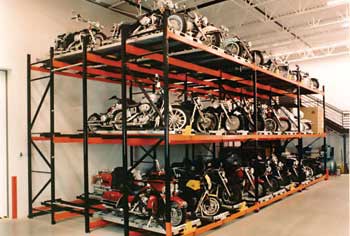Overstocking and How to Prevent It
Overstocking means holding more inventory than is actually needed. While it might sound like a good idea to have extra stock lying around just in case, it can significantly increase your operating costs and erode profits.

What is overstocking?
Overstocking occurs when a business purchases, produces, or stores more inventory than is needed to meet actual customer demand. This often happens due to inaccurate demand forecasting, long lead times, or overly cautious stocking policies. As a result, businesses end up with surplus inventory that sits idle in warehouses, gathering dust and draining resources.
Overstocking can affect any type of inventory, be it finished goods, raw materials, or work-in-process items. In retail, e-commerce, and manufacturing alike, excess stock slows down inventory turnover and increases storage costs, directly impacting profit and cash flow.
Having some buffer inventory is not inherently bad, however. In fact, maintaining a sensible level of safety stock is often a smart way to protect against supply chain disruptions, shortages, or sudden spikes in demand. But overstocking becomes a costly liability when stock consistently exceeds forecasted needs or when goods are purchased without a clear strategy.
Overstocking vs. safety stock
It’s important to distinguish between overstocking and safety stock. Both refer to holding inventory beyond immediate demand, but the intent and management of that stock are different.
Safety stock is a calculated buffer maintained to prevent stockouts caused by unpredictable demand or supply delays. It’s part of a deliberate inventory strategy and is based on metrics like historical sales data, supplier lead times, and demand variability. When done right, safety stock improves order fulfillment and customer satisfaction.
Overstocked inventory, on the other hand, is unplanned and unmanaged. It may be the result of poor forecasting, panic buying, outdated replenishment rules, or misaligned procurement. Instead of supporting your operations, it undermines them by reducing operational efficiency, clogging up storage space, and finally eroding your profits.
Common causes of overstocking
Understanding the causes of overstocking is the first step to prevention. Here are the key culprits:
1. Inaccurate demand forecasting
Relying on gut instinct or outdated spreadsheets for demand forecasting leads to poor inventory planning. If forecasted sales are too high, the business may order or produce more than needed, resulting in excess inventory. Conversely, if forecasted sales are too low, the business risks running out of stock and losing business.
2. Long lead times and bulk ordering
Businesses with long supplier lead times often overorder to avoid stockouts. This approach might prevent understocking, but it can also lead to an accumulation of surplus stock.
Ordering in bulk to save on price per unit can also backfire. If demand doesn’t match the larger quantity, you’re stuck with overstocked items that might cost more to store than they saved upfront.
3. Poor coordination across the supply chain
Miscommunication between departments or across the supply chain can result in duplicated or unnecessary orders. Without real-time visibility into inventory levels, purchasing decisions are often made in isolation, leading to overordering and other costly errors.
4. Sub-par reorder policies
Companies that do not set reorder points for their goods rarely have a good overview of what needs to be ordered and what can be left for the next ordering cycle. Similarly, static reorder points and replenishment schedules can lead to overstocking if they don’t account for changing demand. Businesses that don’t regularly update these settings based on metrics like inventory turnover or demand variability may continue ordering as usual, even when demand drops.
5. New products and obsolescence
When launching new products, businesses may overestimate their initial popularity. If these products underperform, the inventory is left sitting in the warehouse and may eventually become obsolete.
Even popular items can become outdated over time. Electronics, fashion, and perishable goods are especially vulnerable to rapid obsolescence, making inventory tracking and sell-through strategies critical.
6. Mismanaging seasonal demand
Failing to accurately predict and respond to seasonal demand can result in leftover stock. Without proper ramp-down strategies after seasonal peaks, businesses often overorder stock that doesn’t match actual demand.
Consequences of overstocking
Overstocking is more than just an inconvenience. The ripple effects can spread across operations, finance, and customer experience:
1. Tied-up working capital
Every dollar spent on unsold inventory is a dollar not available for other uses like marketing, product development, or hiring. Cash flow becomes strained, especially in small businesses that operate on thinner margins.
2. Increased storage and handling costs
More inventory requires more storage space, labor, equipment, and insurance. These storage costs rise quickly, especially for perishable or high-maintenance goods.
3. Obsolescence and waste
Excess inventory can quickly become outdated or unusable. Obsolescence turns valuable assets into liabilities that may need to be written off or heavily discounted.
4. Eroded profit margins
To clear overstocked inventory, businesses often resort to heavy discounts or liquidation sales. This impacts profit margins and can hurt brand perception.
5. Inefficiencies and missed opportunities
Carrying excess stock clogs up warehouse workflows and slows order fulfillment. It also limits your ability to stock fast-moving or new items, reducing inventory turnover and responsiveness.
How to prevent overstocking
Tackling overstocking requires better tools and smarter workflows. Here’s how to get started:
1. Implement accurate demand forecasting
Use historical sales data and consumer trends to forecast demand more accurately. Modern inventory management software and ERP systems offer easy access to your sales and production data, enabling you to create more accurate forecasts. For manufacturers, these solutions provide tools to quickly calculate material requirements for upcoming months or orders.
2. Set reorder points
Setting mathematically calculated reorder points enables you to know exactly when it’s time to replenish your inventory. Choose a software system that automatically sends out low stock alerts for extra efficiency.
3. Use Just-in-Time (JIT) inventory
JIT inventory strategies help reduce overstocking by timing purchases and production closely with actual demand. While JIT can expose you to risks during supply chain disruptions, it remains a powerful tool when combined with solid forecasting and backup plans.
4. Review and rationalize SKUs
Regularly perform SKU rationalization by auditing your product catalog. Eliminate or bundle slow-moving SKUs, and avoid introducing too many similar new products. Clear, focused offerings reduce the risk of surplus inventory.
5. Improve supplier relationships
Develop strong partnerships with suppliers to reduce lead times and increase order flexibility. Reliable suppliers enable leaner operations and reduce the need for safety stock.
6. Monitor inventory metrics
Track key inventory metrics like inventory turnover rate, days sales of inventory, and spoilage. Regular analysis helps detect early signs of overstocking and informs better decisions.
How ERP software helps prevent overstocking
ERP systems combine data from sales, purchasing, production, and finance to give businesses a complete, real-time view of their inventory. This central visibility is crucial for preventing overstocking.
Here’s how ERP software like MRPeasy can help:
- Real-time inventory tracking
ERP systems provide a clear, up-to-date view of inventory levels across warehouses, production, and sales. This visibility helps prevent overordering by showing exactly what’s in stock and what’s already committed to existing orders. - Reorder point notifications
Many ERP systems allow you to set reorder points. When stock drops below these levels, the system can send alerts so you can reorder at the right time. - Access to historical sales data
Rather than guessing, ERP software gives you accurate historical sales data to base your demand forecasting on. By analyzing trends, seasonality, and past sales performance, you can create more informed forecasts that help align ordering with future demand. - Supplier and lead time tracking
ERP systems track supplier performance and lead times, helping you make better procurement decisions. Knowing how long it takes to receive materials or products allows you to set reorder points and buffer stock more precisely, minimizing surplus stock while avoiding shortages. - Integrated procurement and production planning
With ERP, you can align purchasing and production schedules with actual customer orders and forecasts. This ensures that raw materials and components are ordered only when needed, reducing overstocked inventory and improving inventory turnover.
By using ERP tools to streamline and optimize your inventory strategy, you not only prevent overstocking but also reduce the chances of understocking, missed opportunities, and lost sales—all while understanding your actual costs and achieving end-to-end traceability.
Key takeaways
- Overstocking happens when inventory levels exceed actual customer demand, leading to cash flow strain and increased storage costs.
- Unlike safety stock, which is a strategic buffer, overstocked inventory is typically the result of poor forecasting or misaligned supply chain decisions.
- Common causes of overstocking include inaccurate demand forecasting, long lead times, bulk ordering, and poor coordination across departments.
- Overstocking results in financial losses, operational inefficiencies, environmental waste, and potential damage to customer satisfaction and profit margins.
- Preventing overstocking requires accurate forecasting, setting dynamic reorder points, managing SKUs, and improving supplier collaboration.
- ERP systems help mitigate overstocking by offering real-time inventory visibility, reorder point alerts, historical sales data access, and integrated procurement planning.
Frequently asked questions (FAQ)
Use historical sales data, supplier lead times, and demand variability to calculate safety stock based on a desired service level (e.g., 95% order fulfillment).
You can discount or bundle them for quicker sell-through, donate them to recover goodwill, or liquidate through third-party resellers. Whichever strategy you choose, track and analyze the outcomes to inform better decisions in the future.
Reorder points and inventory policies should be reviewed regularly, ideally quarterly or whenever there are major shifts in demand, supply, or lead times. This ensures that your replenishment strategies stay aligned with real-world conditions and reduce the risk of both overstocking and stockouts.
You may also like: What Is Dead Stock and How to Avoid It?




